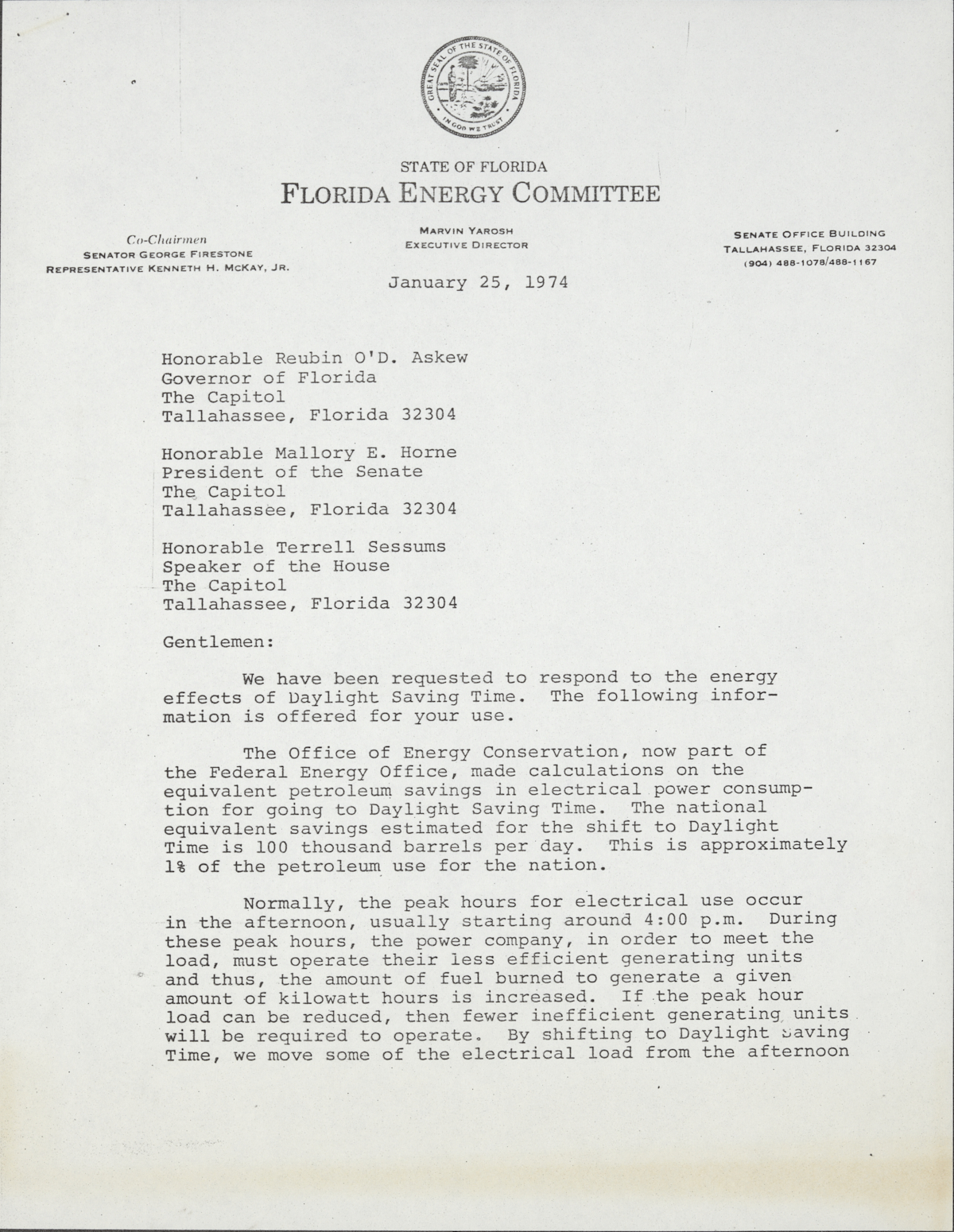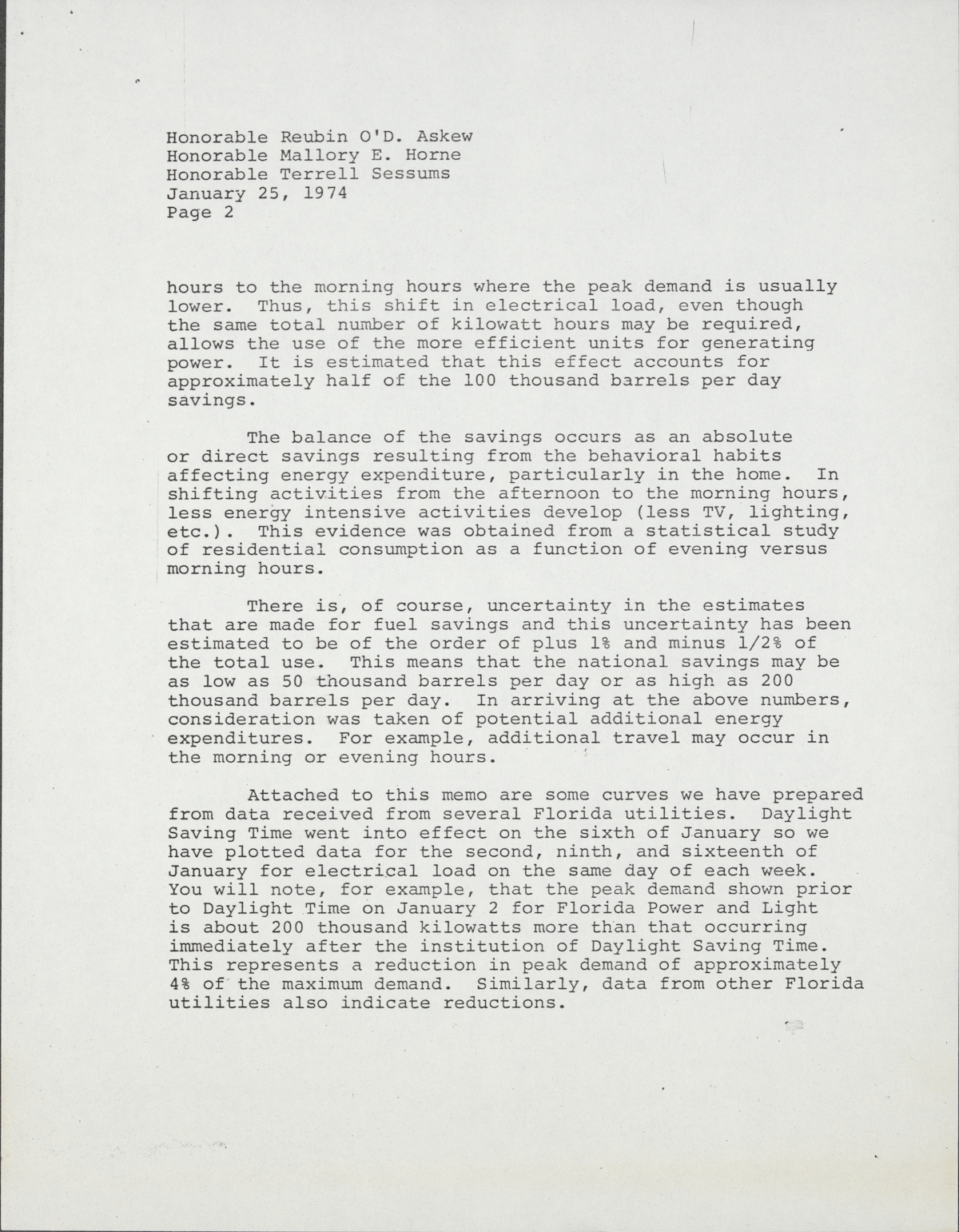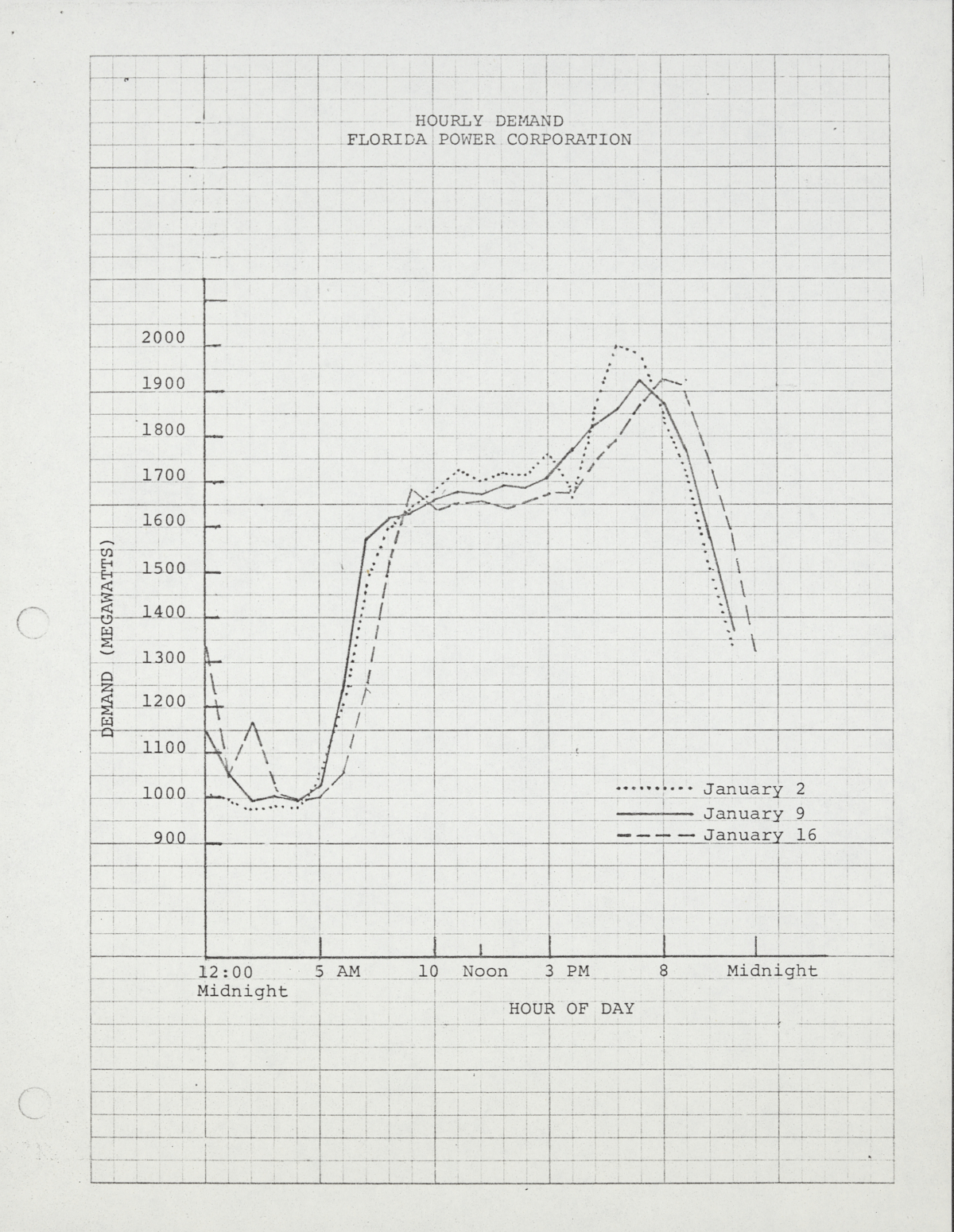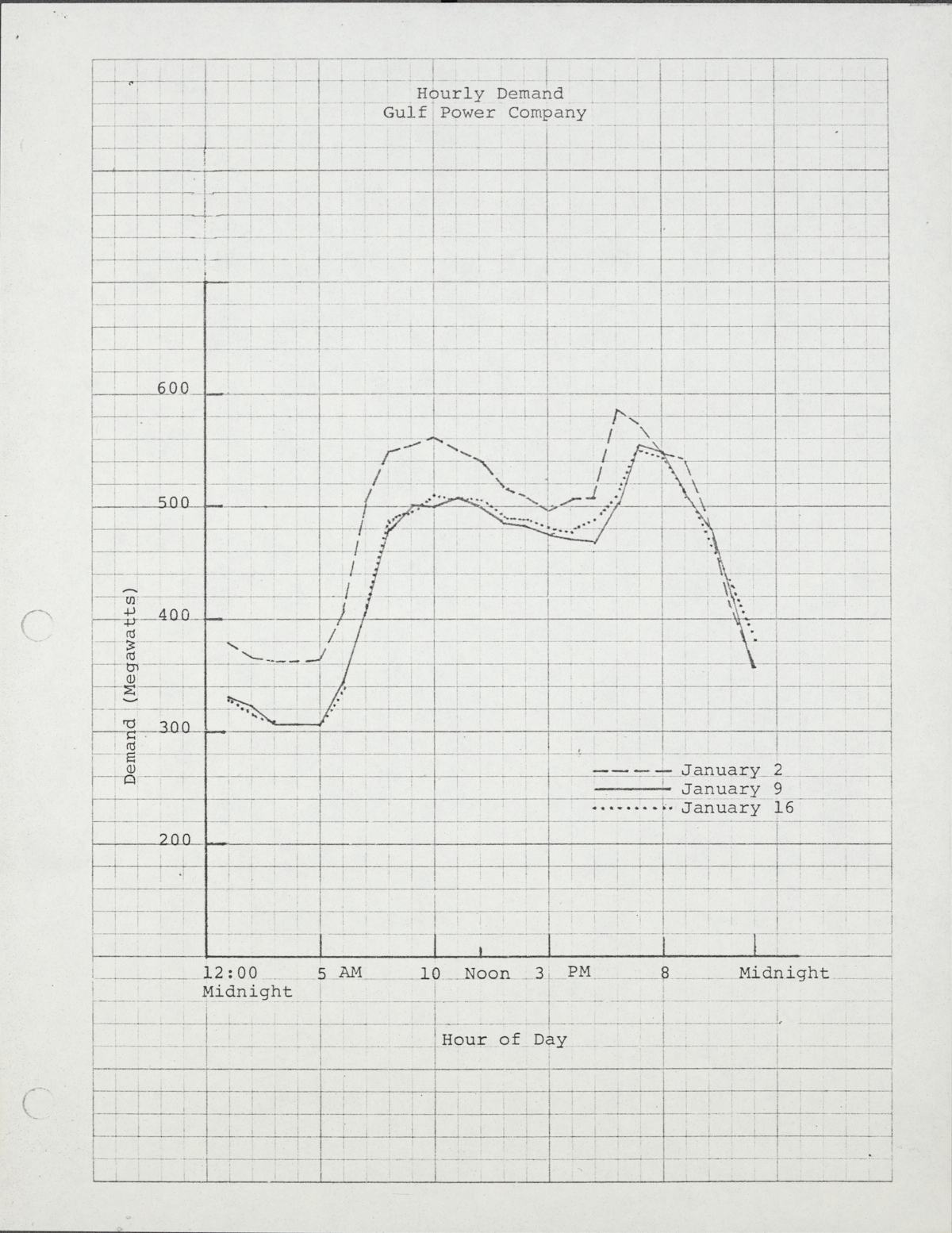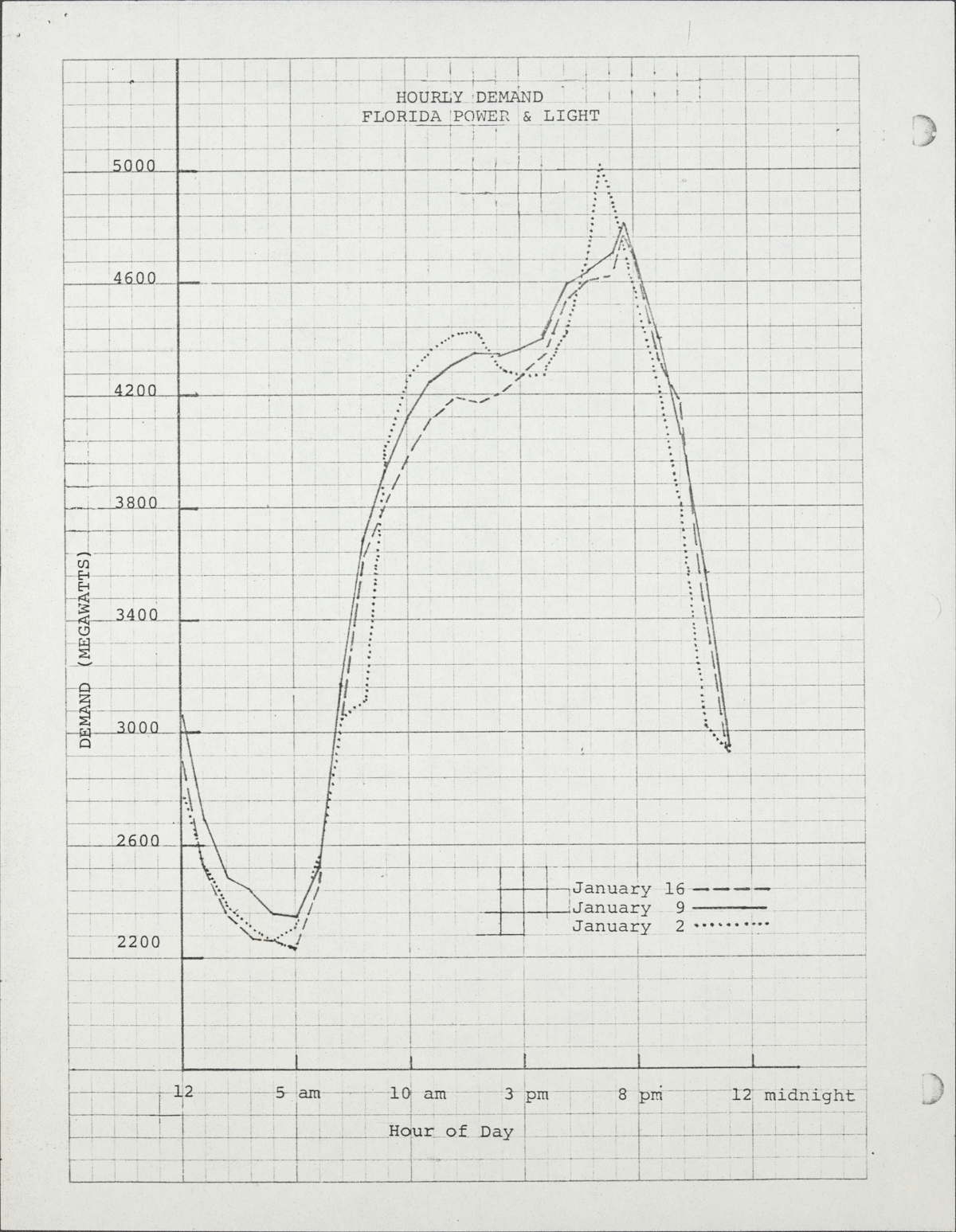Florida Memory is administered by the Florida Department of State, Division of Library and Information Services, Bureau of Archives and Records Management. The digitized records on Florida Memory come from the collections of the State Archives of Florida and the special collections of the State Library of Florida.

State Archives of Florida
- ArchivesFlorida.com
- State Archives Online Catalog
- ArchivesFlorida.com
- ArchivesFlorida.com
State Library of Florida
Related Sites
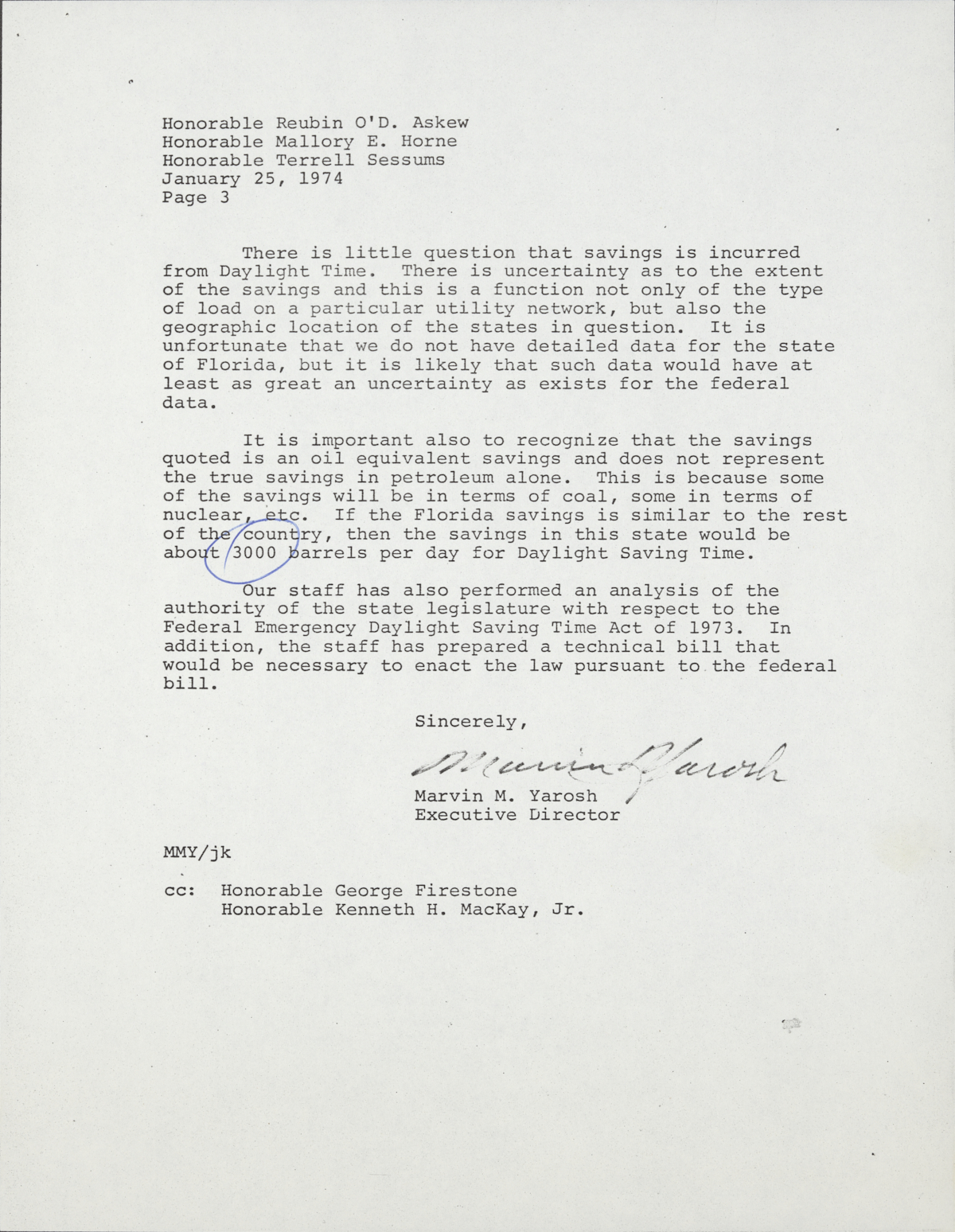
Description of previous item
Description of next item

Letter from Marvin M. Yarosh, Executive Director of the Florida Energy Committee, with attached data about energy demand during Daylight Saving Time, January 25, 1974
Source
Description
Date
Format
Topic
Subjects
Geographic Term
General Note
In Florida, the change to year-round DST came with serious consequences. In the first few weeks after the time change was enacted, several school-aged children were injured in traffic accidents in the dark mornings on their way to school.
In response to these accidents, there was an outpouring of citizen correspondence to Governor Askew expressing their opinions on year-round DST and whether or not Florida should move to counteract the Federal mandate within the state.
On January 29th, 1974, the Florida Legislature met for a special session to discuss DST. At the end of this session, no legislation was passed, and Florida continued to comply with the year-round Daylight Saving Time that President Nixon established.
In 2018, the Florida Legislature passed the “Sunshine Protection Act” (HB1013/SB858), stating that Florida will enact a year-round DST, provided that the federal Uniform Time Act of 1966 is amended to permit states to do so.
It is important also to recognize that the savings quoted is an oil equivalent savings and does not represent | the true Savings in petroleum alone. This is because some of the savings will be in terms of coal, some in terms of nuclear, etc. If the Florida savings is similar to the rest of fancy then the savings in this state would be about (3000 barrels per day for Daylight Saving Time.
Our staff has also performed an analysis of the authority of the state legislature with respect to the Federal Emergency Daylight Saving Time Act of 1973. In addition, the staff has prepared a technical bill that would be necessary to enact the law pursuant to the federal bill.
Sincerely,
Marvin Yarosh [signed]
Marvin M. Yarosh
Executive Director
MMY/jk
cc: Honorable George Firestone
Honorable Kenneth H. MacKay, Jr.
Title
Subject
Description
Creator
Source
Date
Contributor
Format
Language
Type
Identifier
Coverage
Geographic Term
Thumbnail
ImageID
topic
Subject - Corporate
Subject - Person
Transcript
FLORIDA ENERGY COMMITTEE
Co-Chairmen
Senator George Firestone
Representative Kenneth H. McKay, Jr.
Marvin Yarosh
Executive Director
Senate Office Building
Tallahassee, Florida 32304
(904) 488-107/488-1167
January 25, 1974
Honorable Reubin O'D. Askew
Governor of Florida
The Capitol
Tallahassee, Florida 32304
Honorable Mallory E. Horne
President of the Senate
The Capitol
Tallahassee, Florida 32304
Honorable Terrell Sessums
Speaker of the House
The Capitol
Tallahassee, Florida 32304
Gentlemen:
We have been requested to respond to the energy effects of Daylight Saving Time. The following information is offered for your use.
The Office of Energy Conservation, now part of the Federal Energy Office, made calculations on the equivalent petroleum savings in electrical power consumption for going to Daylight Saving Time. The national equivalent savings estimated for the shift to Daylight Time is 100 thousand barrels per day. This is approximately 1% of the petroleum use for the nation.
Normally, the peak hours for electrical use occur in the afternoon, usually starting around 4:00 p.m. During these peak hours, the power company, in order to meet the load, must operate their less efficient generating units and thus, the amount of fuel burned to generate a given amount of kilowatt hours is increased. If the peak hour load can be reduced, then fewer inefficient generating units will be required to operate. By shifting to Daylight saving Time, we move some of the electrical load from the afternoon
The balance of the Savings occurs as an absolute or direct savings resulting from the behavioral habits affecting energy expenditure, particularly in the home. In shifting activities from the afternoon to the morning hours, less energy intensive activities develop (less TV, lighting, etc.). This evidence was obtained from a statistical study | of residential consumption as a function of evening versus morning hours.
There is, of course, uncertainty in the estimates that are made for fuel savings and this uncertainty has been estimated to be of the order of plus 1% and minus 1/23 of the total use. This means that the national savings may be as low as 50 thousand barrels per day or as high as 200 thousand barrels per day. In arriving at the above numbers, consideration was taken of potential additional energy expenditures. For example, additional travel may occur in the morning or evening hours.
Attached to this memo are some curves we have prepared from data received from several Florida utilities. Daylight Saving Time went into effect on the sixth of January so we have plotted data for the second, ninth, and sixteenth of January for electrical load on the same day of each week. , You will note, for example, that the peak demand shown prior to Daylight Time on January 2 for Florida Power and Light is about 200 thousand kilowatts more than that occurring immediately after the institution of Daylight Saving Time. This represents a reduction in peak demand of approximately 4% of the maximum demand. Similarly, data from other Florida utilities also indicate reductions.
It is important also to recognize that the savings quoted is an oil equivalent savings and does not represent | the true Savings in petroleum alone. This is because some of the savings will be in terms of coal, some in terms of nuclear, etc. If the Florida savings is similar to the rest of fancy then the savings in this state would be about (3000 barrels per day for Daylight Saving Time.
Our staff has also performed an analysis of the authority of the state legislature with respect to the Federal Emergency Daylight Saving Time Act of 1973. In addition, the staff has prepared a technical bill that would be necessary to enact the law pursuant to the federal bill.
Sincerely,
Marvin Yarosh [signed]
Marvin M. Yarosh
Executive Director
MMY/jk
cc: Honorable George Firestone
Honorable Kenneth H. MacKay, Jr.
General Note
In Florida, the change to year-round DST came with serious consequences. In the first few weeks after the time change was enacted, several school-aged children were injured in traffic accidents in the dark mornings on their way to school.
In response to these accidents, there was an outpouring of citizen correspondence to Governor Askew expressing their opinions on year-round DST and whether or not Florida should move to counteract the Federal mandate within the state.
On January 29th, 1974, the Florida Legislature met for a special session to discuss DST. At the end of this session, no legislation was passed, and Florida continued to comply with the year-round Daylight Saving Time that President Nixon established.
In 2018, the Florida Legislature passed the “Sunshine Protection Act” (HB1013/SB858), stating that Florida will enact a year-round DST, provided that the federal Uniform Time Act of 1966 is amended to permit states to do so.
Chicago Manual of Style
Yarosh, Marvin M., 1926-2004. Letter from Marvin M. Yarosh, Executive Director of the Florida Energy Committee, with attached data about energy demand during Daylight Saving Time, January 25, 1974. 1974-01-25. State Archives of Florida, Florida Memory. <https://www.floridamemory.com/items/show/350886>, accessed 27 December 2025.
MLA
Yarosh, Marvin M., 1926-2004. Letter from Marvin M. Yarosh, Executive Director of the Florida Energy Committee, with attached data about energy demand during Daylight Saving Time, January 25, 1974. 1974-01-25. State Archives of Florida, Florida Memory. Accessed 27 Dec. 2025.<https://www.floridamemory.com/items/show/350886>
AP Style Photo Citation
(State Archives of Florida/Yarosh)

 Listen: The Blues Program
Listen: The Blues Program